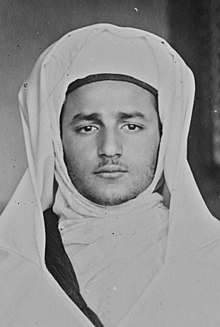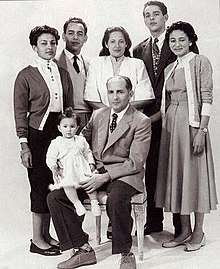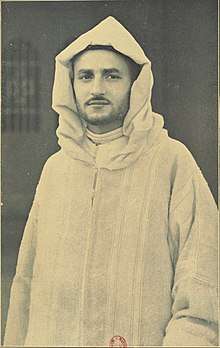Mohammed V of Morocco
Mohammad Al-Khamis Ben Youssef Ben Mohammed Al-Alaoui (Arabic: محمد الخامس بن يوسف بن الحسن بن محمد بن عبد الرحمن بن هشام بن محمد بن عبد الله بن إسماعيل بن إسماعيل بن الشريف بن علي العلوي), known as Mohammed V (10 August 1909 – 26 February 1961) (Arabic: محمد الخامس), was Sultan of Morocco from 1927 to 1953; he was recognized as Sultan again upon his return from exile in 1955, and as King from 1957 to 1961. His full name was Sidi Mohammed ben Yusef, or Son of (Sultan) Yusef, upon whose death he succeeded to the throne. He was a member of the Alaouite dynasty.
| Mohammed V محمد الخامس | |
|---|---|
| Amir al-Mu'minin | |
.jpg) | |
| King of Morocco | |
| Reign | 14 August 1957 – 26 February 1961 |
| Successor | Hassan II |
| Prime Ministers | |
| Sultan of Morocco | |
| Reign | 30 October 1955 – 14 August 1957 |
| Predecessor | Mohammed Ben Aarafa |
| Reign | 17 November 1927 – 20 August 1953 |
| Predecessor | Yusef |
| Successor | Mohammed Ben Aarafa |
| Born | 10 August 1909 Fes, Morocco |
| Died | 26 February 1961 (aged 51) Rabat, Morocco |
| Burial | |
| Spouse | Lalla Hanila bint Mamoun Lalla Abla bint Tahar Lalla Bahia bint Antar |
| Issue | Princess Fatima Zohra Hassan II Princess Aicha Princess Malika Prince Abdallah Princess Nuzha Princess Amina |
| House | Alaouite dynasty |
| Father | Yusef |
| Mother | Lalla Yaqut |
| Religion | Sunni Islam |
Biography

Mohammed V was one of the sons of Sultan Yusef, who was enthroned by the French in September 1912 and his wife Lalla Yaqut, who was of Turkish origin.[1] On 18 November 1927, a "young and timid" 17-year-old Muhammad b. Yusuf was enthroned after the death of his father and the departure of Hubert Lyautey.[2]
He married Lalla Hanila bint Mamoun in 1925 and in 1929, he married Lalla Abla bint Tahar, who also gave birth to Hassan II in 1929.
Berber Dahir
At the time of Muhammad's enthronement, the French colonial authorities were "pushing for a more assertive 'native policy.'"[2] On 16 May 1930, Sultan Muhammad V signed the Berber Dahir, which changed the legal system in parts of Morocco where Amazigh languages were primarily spoken (Bled es-Siba), while maintaining the legal system in the rest of the country (Bled el-Makhzen) remained the way it had been before the French invasion.[2][3] Although the sultan was under no duress, he was only 20 years old.[2] This dhahir "electrified the nation"; it was sharply criticized by Moroccan nationalists and catalyzed the Moroccan Nationalist Movement.[2]
Anfa Conference
Sultan Muhammad V participated in the Anfa Conference hosted in Casablanca during World War II.[2] On 22 January 1943, he met privately with the US president Franklin Delano Roosevelt Jr. and the Prime Minister of the UK Winston Churchill.[2] At this dinner, Roosevelt assured the sultan that "the post-war scene and the pre-war scene would ... sharply differ, especially as they related to the colonial question."[2] The sultan's 14-year-old son and future king of Morocco, Hassan II, also attended and later stated that Roosevelt said, "Ten years from now your country will be independent."[2]
Holocaust
"There are competing accounts of exactly what Mohammed V did or did not do for the Moroccan Jewish community" during the Holocaust.[4] However, "though a subject of debate, most scholars stress the benevolence of Mohammed V toward the Jews" during the Vichy era.[5] Mohammed blocked efforts by Vichy officials to impose anti-Jewish legislation upon Morocco and deport the country's 250,000 Jews to their deaths in Nazi concentration camps and extermination camps in Europe.[6] The sultan's stand was "based as much on the insult the Vichy diktats posed to his claim of sovereignty over all his subjects, including the Jews, as on his humanitarian instincts."[6] Partial Nazi race measures were enacted in Morocco over Mohammed's objection,[6] and Mohammed did sign, under the instructions of Vichy officials, two dahirs (decrees) that barred Jews from certain schools and positions.[7]
Nevertheless, Mohammed is highly esteemed by Moroccan Jews who credit him for protecting their community from the Nazi and Vichy French government,[4] and Mohammed V has been honored by Jewish organizations for his role in protecting his Jewish subjects during the Holocaust.[8] Some historians maintain that Mohammed's anti-Nazi role has been exaggerated; historian Michel Abitol writes that while Mohammed V was compelled by Vichy officials to sign the anti-Jewish dahirs, "he was more passive than Moncef Bay (ruler of Tunisia during the Second World War) in that he did not take any side and did not engage in any public act that could be interpreted as a rejection of Vichy's policy."[7]
Revolution of the King and the People
Sultan Muhammad V was a central figure in the independence movement in Morocco, or as it is also called: the Revolution of the King and the People (ثورة الملك والشعب). This Moroccan Nationalist Movement grew from protests regarding the Berber Dahir of 16 May 1930. His central position in the Proclamation of Independence of Morocco further boosted his image as a national symbol. On 10 April 1947, he delivered a momentous speech in Tangier, appealing for the independence of Morocco, without calling out specific colonial powers.[9]
Exile

On 20 August 1953 (the eve of Eid al-Adha), the French colonial authorities forced Mohammed V, an important national symbol in the growing Moroccan independence movement, into exile in Corsica along with his family. His first cousin once removed, Mohammed Ben Aarafa, called the "French sultan," was made a puppet monarch and placed on the throne.[10] In response, Muhammad Zarqtuni bombed Casablanca's Central Market on Christmas Eve of that year.[10]
Mohammed V and his family were then transferred to Madagascar in January 1954. Mohammed V returned from exile on 16 November 1955, and was again recognized as Sultan after active opposition to the French protectorate. In February 1956 he successfully negotiated with France and Spain for the independence of Morocco, and in 1957 took the title of King.
Death
He died at 51 years old 26 February 1961 following complications of a minor operation he had undergone.[11]
Legacy
The Mohammed V International Airport and Stade Mohamed V of Casablanca are named after him, as well as numerous universities and various public spaces across Morocco. There is an Avenue Mohammed V in nearly every Moroccan city and a major one in Tunis, Tunisia.
In December 2007, The Jewish Daily Forward reported on a secret diplomatic initiative by the Moroccan government to have Mohammed V admitted to the Righteous Among the Nations.[12]
Personal life
His first wife was Lalla Hanila bint Mamoun. They married in 1925.[13][14] She was the mother of his first daughter Lalla Fatima Zohra.
His second wife was his first cousin Lalla Abla bint Tahar (Arabic: لالا عبلة بنت طهار) (born 5 September 1909 – died 1 March 1992). She was the daughter of Moulay Mohammed Tahar bin Hassan, son of Hassan I of Morocco. She married Mohammed V in 1929 and died in Rabat on 1 March 1992. She gave birth to five children: the future King Hassan II, Lalla Aicha, Lalla Malika, Moulay Abdallah and Lalla Nuzha.[15]
His third wife was Lalla Bahia bint Antar, mother of his last daughter Lalla Amina.
Honours

- Order of Blood of the Tunisian Republic
- Grand Cross of the Legion of Honour of the French Republic-1927
- Collar of the Order of Charles III of the Kingdom of Spain-1929[16]
- Companion of the Order of Liberation of the French Republic-1945
- Chief Commander of the Legion of Merit of the United States-1945
- Grand Collar of the Order of the Yoke and Arrows of Francoist Spain-03/04/1956[17]
- Grand Collar of the Order of Idris I of the Kingdom of Libya-1956
- Collar of the Order of the Hashemites of the Kingdom of Iraq-1956
- Grand Cordon of the Order of Umayyad of Syria-1960
- Grand Cordon of the Order of Merit of Lebanon, special class-1960
- Collar of the Order of the Nile of the Republic of Egypt-1960
- Collar of the Order of Al-Hussein bin Ali of Jordan-1960
- Grand Cordon of the King Abdulaziz Decoration of Saudi Arabia-1960
See also
- History of Morocco
- List of Kings of Morocco
- Mausoleum of Mohammed V
- Mohamed V Dam
- Mohammed V University
References
- Prince Moulay Hicham El Alaoui. Journal d'un Prince Banni: Demain le Maroc (Grasset ed.). 9 April 2014. ISBN 978-2-246-85166-0.
allait devenir la petite-fille préférée de Hassan II, le roi s’est émerveillé sans aucune gêne des yeux bleus de la nouveau-née. « Elle tient ça de son arrière-grand-mère turque », faisait-il remarquer en rappelant les yeux azur de la mère de Mohammed V
CS1 maint: location (link) - Miller, Susan Gilson. (2013). A history of modern Morocco. New York: Cambridge University Press. ISBN 978-1-139-62469-5. OCLC 855022840.
- "الأمازيغية والاستعمار الفرنسي (24) .. السياسة البربرية والحرب". Hespress (in Arabic). Retrieved 13 January 2020.
- Jessica M. Marglin, Across Legal Lines: Jews and Muslims in Modern Morocco (Yale University Press, 2016), p. 201.
- Orit Bashkin & Daniel J. Schroeter, "Historical themes: Muslim-Jewish relations in the modern modern Middle East and North Africa" in The Routledge Handbook of Muslim-Jewish Relations (Routledge, 2016), p. 54.
- Susan Gilson Miller, A History of Modern Morocco (Cambridge University Press, 2013), pp. 142-43.
- Abdelilah Bouasria, "The second coming of Morocco's 'Commander of the Faithful': Mohammed VI and Morocco's religious policy" in Contemporary Morocco: State, Politics and Society Under Mohammmed VI (eds. Bruce Maddy-Weitzman & Daniel Zisenwine, 2013), p. 42.
- "KIVUNIM Convocation Honoring the Memory of King Mohammed V of Morocco". Kivunim. 24 December 2015.
- Atlasinfo. "Evènements du 7 avril 1947 à Casablanca, un tournant décisif dans la lutte pour la liberté et l'indépendance". Atlasinfo.fr: l'essentiel de l'actualité de la France et du Maghreb (in French). Retrieved 29 August 2019.
- Yabiladi.com. "Histoire : Le Noël sanglant du marché central de Casablanca". www.yabiladi.com (in French). Retrieved 5 July 2020.
- "Mohammed V of Morocco Dies at 51 After Surgery". New York Times. 26 February 1961. Retrieved 13 June 2008.
King Mohammed V died today after a minor operation. He was 51 years old and had occupied the throne since 1927
- An Arab King Righteous Among the Nations?. The Forward, 12 December 2007
- Triple royal wedding in Morocco
- Zeyna (13 August 2014). "Feue la princesse Lalla Fatima Zahra décedée le 10 aout 2014". Skyrock (in French). Retrieved 24 February 2018.
- International Business Publications, Morocco Foreign Policy and Government Guide p. 84
- Guía oficial de España, p. 211
- Boletín Oficial del Estado
Bibliography
- David Bensoussan, Il était une fois le Maroc : témoignages du passé judéo-marocain, éd. du Lys, www.editionsdulys.ca, Montréal, 2010 (ISBN 2-922505-14-6); Second edition : www.iuniverse.com, Bloomington, IN, 2012, ISBN 978-1-4759-2608-8, 620p. ISBN 978-1-4759-2609-5 (ebook);
External links
| Wikimedia Commons has media related to Mohammed V of Morocco. |
- History of Morocco (in French)
| Regnal titles | ||
|---|---|---|
| Preceded by Yusef |
Sultan of Morocco 1927–1953 |
Succeeded by Mohammed Ben Aarafa |
| Preceded by Mohammed Ben Aarafa |
Sultan of Morocco 1955–1957 |
Succeeded by Himself as King |
| Preceded by Himself as Sultan |
King of Morocco 1957–1961 |
Succeeded by Hassan II |